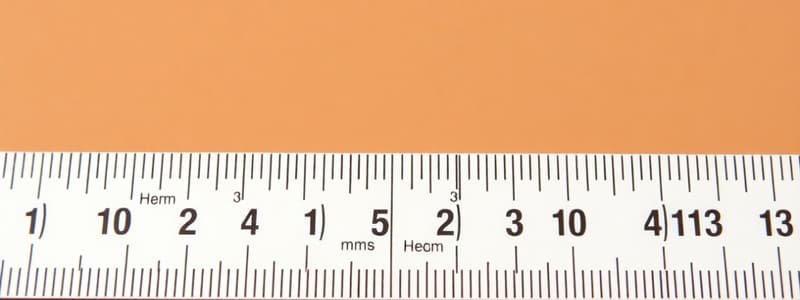Podcast
Questions and Answers
What is the meaning of the prefix 'kilo'?
What is the meaning of the prefix 'kilo'?
- Hundred
- Tenth
- Ten
- Thousand (correct)
What factor does the prefix 'Hecto' represent?
What factor does the prefix 'Hecto' represent?
- 10
- 100 (correct)
- 1,000
- 0.1
Which of the following is the base unit for volume in the metric system?
Which of the following is the base unit for volume in the metric system?
- Liter (correct)
- Meter
- Deci
- Gram
What does the prefix 'milli' represent?
What does the prefix 'milli' represent?
How many grams are in 1 kilogram?
How many grams are in 1 kilogram?
How many liters are in a hectoliter?
How many liters are in a hectoliter?
What is the value of 1 cm in meters?
What is the value of 1 cm in meters?
Which mnemonic is recommended for remembering the order of metric prefixes?
Which mnemonic is recommended for remembering the order of metric prefixes?
If you are converting from grams to milligrams, which direction do you move the decimal place?
If you are converting from grams to milligrams, which direction do you move the decimal place?
What does the 'D' stand for in the 'Dr. D.A.' medication calculation mnemonic?
What does the 'D' stand for in the 'Dr. D.A.' medication calculation mnemonic?
In the formula (Desired Dose ÷ Dose on Hand) × Volume, what does this calculation provide?
In the formula (Desired Dose ÷ Dose on Hand) × Volume, what does this calculation provide?
According to the 'Volume Over Time' formula, volume is divided by what to calculate IV flow rate?
According to the 'Volume Over Time' formula, volume is divided by what to calculate IV flow rate?
What is the first step in the 'Divide by Two, Subtract a Tenth' method for converting pounds to kilograms?
What is the first step in the 'Divide by Two, Subtract a Tenth' method for converting pounds to kilograms?
According to the pediatric weight estimation formula, what number is added to (Age × 2)?
According to the pediatric weight estimation formula, what number is added to (Age × 2)?
What is the dose of Epinephrine 1:10,000 for cardiac arrest, according to the 'One-Fifty-Fifty' rule?
What is the dose of Epinephrine 1:10,000 for cardiac arrest, according to the 'One-Fifty-Fifty' rule?
According to the 'Rule of 9s', what percentage does the head represent in estimating burn percentage?
According to the 'Rule of 9s', what percentage does the head represent in estimating burn percentage?
What percentage does each arm represent in the 'Rule of 9s' for burn estimation?
What percentage does each arm represent in the 'Rule of 9s' for burn estimation?
According to the 'Rule of 9s', what percentage of the body is the perineum?
According to the 'Rule of 9s', what percentage of the body is the perineum?
What is the cylinder factor for an E tank in the oxygen tank duration calculation?
What is the cylinder factor for an E tank in the oxygen tank duration calculation?
In the Parkland formula, what is the multiplication factor for TBSA% and weight in kilograms to calculate the fluid requirement in the first 24 hours?
In the Parkland formula, what is the multiplication factor for TBSA% and weight in kilograms to calculate the fluid requirement in the first 24 hours?
Flashcards
Metric System
Metric System
A system of measurement based on powers of 10, facilitating straightforward conversions.
Kilo (k)
Kilo (k)
Thousand (1,000), Factor ×1,000
Hecto (h)
Hecto (h)
Hundred (100), Factor ×100
Deca (da)
Deca (da)
Signup and view all the flashcards
Base Unit
Base Unit
Signup and view all the flashcards
Deci (d)
Deci (d)
Signup and view all the flashcards
Centi (c)
Centi (c)
Signup and view all the flashcards
Milli (m)
Milli (m)
Signup and view all the flashcards
Micro (μ)
Micro (μ)
Signup and view all the flashcards
Mnemonic for Metric Order
Mnemonic for Metric Order
Signup and view all the flashcards
kg to g Conversion Rule
kg to g Conversion Rule
Signup and view all the flashcards
g to mg Conversion Rule
g to mg Conversion Rule
Signup and view all the flashcards
mg to mcg Conversion Rule
mg to mcg Conversion Rule
Signup and view all the flashcards
"Dr. D.A." Meaning
"Dr. D.A." Meaning
Signup and view all the flashcards
"Vicious Dogs Bite"
"Vicious Dogs Bite"
Signup and view all the flashcards
Gtt/min Formula
Gtt/min Formula
Signup and view all the flashcards
IV Flow Rate Formula
IV Flow Rate Formula
Signup and view all the flashcards
Pounds to Kilograms
Pounds to Kilograms
Signup and view all the flashcards
Pediatric Weight Estimation
Pediatric Weight Estimation
Signup and view all the flashcards
"One-Fifty-Fifty"
"One-Fifty-Fifty"
Signup and view all the flashcards
Study Notes
Basic Metric System Conversions
- Metric system relies on powers of 10 for straightforward conversions
- Kilo (k) means thousand (1,000), with a factor of ×1,000; e.g., 1 kg = 1,000 g
- Hecto (h) means hundred (100), with a factor of ×100; e.g., 1 hL = 100 L
- Deca (da) means ten (10), with a factor of ×10; e.g., 1 dag = 10 g
- Gram (g), Liter (L), and Meter (m) are Base Units, with a factor of 1
- Deci (d) means tenth (0.1), with a factor of ÷10; e.g., 1 dL = 0.1 L
- Centi (c) means hundredth (0.01), with a factor of ÷100; e.g., 1 cm = 0.01 m
- Milli (m) means thousandth (0.001), with a factor of ÷1,000; e.g., 1 mg = 0.001 g
- Micro (µ) means millionth (0.000001), with a factor of ÷1,000,000; e.g., 1 µg = 0.000001 g
- Mnemonic to remember the order: "King Henry Died By Drinking Chocolate Milk" (Kilo, Hecto, Deca, Base, Deci, Centi, Milli)
- To go to a larger unit, divide by 10 per step
- To go to a smaller unit, multiply by 10 per step
Medical Math Mnemonics & Shortcuts
- "Move Three Rule" simplifies common conversions
- kg to g: Move decimal three places to the right (1 kg = 1,000 g)
- g to mg: Move decimal three places to the right (1 g = 1,000 mg)
- mg to mcg: Move decimal three places to the right (1 mg = 1,000 mcg)
- Reverse direction to convert mcg to mg (move decimal three places to the left)
"Dr. D.A." for Medication Dosage Calculations
- Desired Dose: The required amount
- Reference Dose: What is available
- Dose Available: Concentration on hand
- Amount to Give: The final calculated answer
Medication Dosage Calculation Formula
- (Desired Dose ÷ Dose on Hand) × Volume = Amount to Give
- Example: For an order of 500 mg with 250 mg per 5 mL on hand, use (500 mg ÷ 250 mg) × 5 mL to get 10 mL
IV Drip Rate Calculation
- "Vicious Dogs Bite" helps determine IV drip rate
- To calculate drops per minute (gtt/min): (Volume (mL) × Drop Factor (gtt/mL)) ÷ Time (min) = gtt/min
- Example: 1,000 mL NS over 4 hours with a 15 gtt/mL set is (1000 × 15) ÷ 240 = 63 gtt/min
IV Flow Rate Calculation
- "Volume Over Time" determines IV flow rate
- To calculate IV flow rate: Volume (mL) ÷ Time (hr) = mL/hr
- Example: 500 mL over 4 hours is 500 ÷ 4 = 125 mL/hr
Pounds to Kilograms Conversion
- Method: "Divide by Two, Subtract a Tenth”
- Halve the weight in pounds
- Subtract 10% of the halved number
- Example: For 180 lbs, half is 90, 10% of 90 is 9, so 90 - 9 = 81 kg (actual is 81.6 kg)
- Quick estimate: Divide pounds by 2.2 (180 ÷ 2.2 = 81.8 kg)
Pediatric Weight Estimation
- Use for children ages 1-10 years: (Age × 2) + 8 = weight in kg
- Example: A 5-year-old's weight is estimated by (5 × 2) + 8 = 18 kg
Pediatric Medication Dosing Shortcut
- "One-Fifty-Fifty" assists in dosing
- 1 mg/kg for Epinephrine 1:10,000 in cardiac arrest cases
- 50 mg/kg for Dextrose administration
- 50 mg/kg for Diphenhydramine administration
Parkland Formula for Burn Patients
- Formula: 4 × TBSA% × Weight (kg) = total fluid in first 24 hours
- Administer half of the total fluid in the first 8 hours
- Administer the remaining half over the next 16 hours
- Example: For 40% burns on a 70 kg patient, 4 × 40 × 70 = 11,200 mL total fluid
- Give 5,600 mL in the first 8 hours, then 5,600 mL in the next 16 hours
"Rule of 9s" for Burn Percentage
- Head = 9%
- Each arm = 9% (4.5% front, 4.5% back)
- Each leg = 18% (9% front, 9% back)
- Torso (front) = 18%
- Torso (back) = 18%
- Perineum = 1%
Oxygen Tank Duration Calculation
- Formula: ((PSI - Safe Residual) × Cylinder Factor) ÷ Flow Rate (L/min) = Minutes Remaining
- Cylinder Factors:
- D tank = 0.16
- E tank = 0.28
- M tank = 1.56
- Example: E tank at 2,000 psi, running at 10 L/min: ((2000 - 200) × 0.28) ÷ 10 = 50.4 minutes
Studying That Suits You
Use AI to generate personalized quizzes and flashcards to suit your learning preferences.




